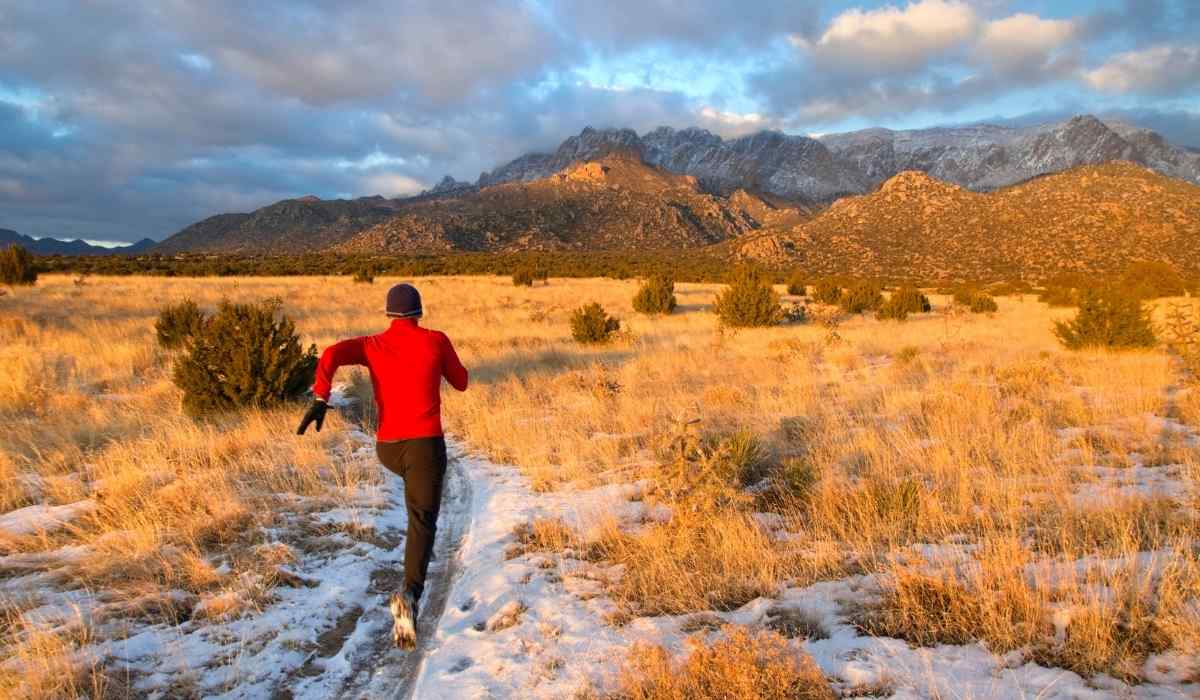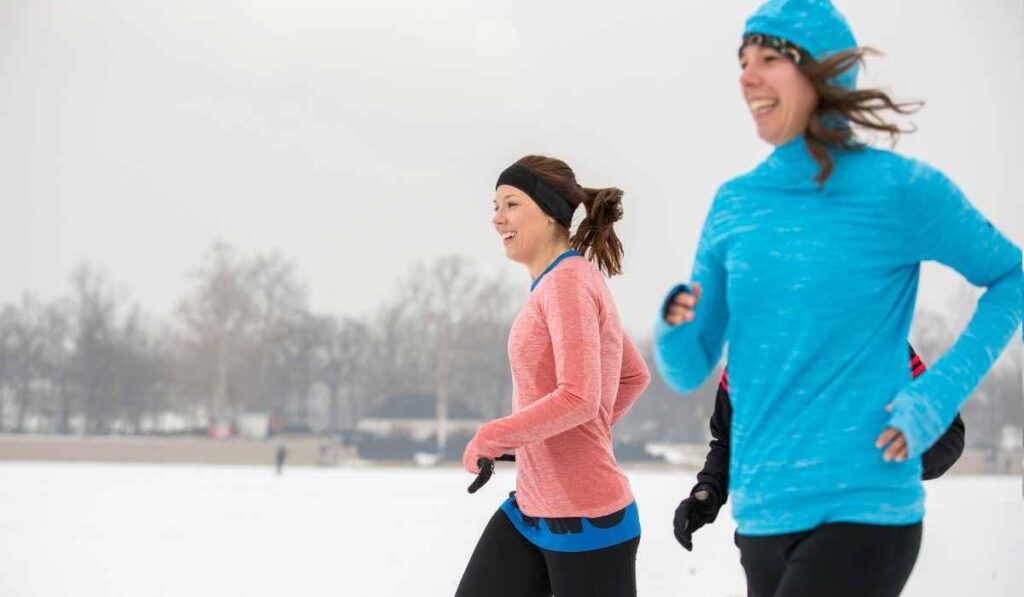
19 Tips for Running in Challenging Conditions
Runners who live in areas that get very hot or very cold often have to face the harsh realities of running in extreme outdoor conditions. Although it’s not always ideal, knowing how to run well in these conditions can enhance your experience and keep you safe. Here’s what you need to know if you plan to head out for a run when it’s particularly warm or chilly outdoors.
How can I run better in hot weather?

When you run outside in the heat, it’s important to take certain precautions to stay safe and comfortable. Technically, you can run outdoors year-round, but consider these tips before you head out for the best experience possible.
1. Drink plenty of water.
Hydration is so important, regardless of the weather, but you’ll lose more fluids through sweat when it’s hot. The sooner you start drinking water, the less stress your body will experience from dehydration, so it’s best to start drinking early and often while you run. Water is generally sufficient, but you can also drink sports drinks with balanced electrolytes to help replace the salt you lose when sweating.1
2. Choose your clothing wisely.
When running in the heat, it’s best to dress as lightly as possible. Choose light colors (not black!) and lightweight and moisture-wicking materials. Avoid cotton at all costs. Cotton gets heavy and traps moisture, leaving you feeling extra hot, sweaty, and unable to cool yourself down.
3. Wear sunscreen.
Of course, sunscreen is a must if you plan on running in the heat. You’ll likely be running when the sun is out, so you should cover any exposed skin, such as your face, arms, legs, and torso (if you’re running in a sports bra or shirtless). Even if you’re one of the lucky few who don’t tend to burn, it’s best to protect your skin from sun damage, especially if you plan to run outdoors frequently in the summertime.
4. Shade your face with a hat.
Even if you’re wearing sunscreen, it’s also a good idea to shade your face and eyes from the sun with a hat. You can even get a moisture-wicking cap designed for runners to help keep your head cool while you work up a sweat.
5. Run early or late.
When it’s hot, many runners choose to run before the sun rises because that’s when it’s most cool. However, if you’re not into morning running or have trouble getting out the door for a run in the morning, consider running in the evening after the hottest part of the day is over.
6. Go slow.
The heat will naturally slow your pace; unfortunately, there’s no fighting it. Instead, just slow down and know that you’re probably not going to set any new personal records while running in the scorching weather.
7. Run in shady areas.
Plan your route in advance and head to shaded areas like parks or city streets lined with trees. Try to run in grassy areas, too. Concrete and asphalt can radiate extra heat, making you feel warmer as you run. The shade will help keep you cool and prevent sunburns, dehydration, and heat exhaustion. Check out our post if you are also wondering if you should run with allergies.
8. Know the signs of heat exhaustion.
Heat exhaustion is a real risk when running in very hot weather. Anyone can get it, and it may set in very quickly or over several hours. Signs of heat exhaustion include:2
- Extreme tiredness
- Dizziness
- Headache
- Excessive sweating
- Clammy skin
- Heat rash
- Cramps in the arms, legs, or stomach
- Fast breathing or heart rate
- High body temperature
- Extreme thirst
- Weakness
If you experience any of these signs of heat exhaustion, get to a cooler place immediately, shed any unnecessary clothing, rest, and hydrate. If you can’t get cool within 30 minutes, you may be experiencing heat stroke, and you should get emergency help immediately.
How hot is too hot to run?

According to the Road Runners Club of America, you should avoid running outdoors if the heat is above 98.6 degrees Fahrenheit and the humidity is above 70 to 80%. High humidity can prevent sweat from evaporating off your skin, making you overheat very quickly.3
If it’s too hot to run outdoors safely, try to be flexible. Alternative activities like swimming or strength training can be great cross-training activities for runners. You can also run indoors on a treadmill with Vingo! Explore exciting routes all over the world with minimal equipment required. You can even run with friends and create a private chat group to keep up with your running buddies while you run virtually together.
How do I get better at running in the cold?

Running in cold weather can be tricky, but it’s entirely possible if you prepare and dress wisely. Before you go, check the temperature and storm warnings so you don’t get caught in crazy winter weather.
1. Do your warmup inside.
Warm up with dynamic stretches at home before you go outside. Once your muscles are warmed up, it won’t feel so miserable heading outdoors into the cold air, and you’ll start your run feeling more comfortable.
2. Wear layers.
Typically, you’ll want to dress for slightly warmer weather than what the temperature says outside. Your body will get warmer as you run, so it’s wise to wear two or three loose layers made up of moisture-wicking materials. You can peel layers off to stay comfortable if you get too warm.
3. Stay hydrated.
You may not feel as thirsty while running in the winter, but hydration is still just as important as ever! Bring your water bottle along with you and take small sips frequently, even if you don’t feel like you need it.
4. Be prepared for potential falls.
Snow and ice can be dangerous hazards while running outdoors in cold weather. To help prevent slips and falls, use a traction device that attaches to the bottom of your running shoes. You can buy traction cleats online or at your local sports or running store. You should also always bring your phone with you, just in case you fall in an area with limited visibility and need someone to help you.
5. Cover up.
The cold weather can be really harsh on your skin, so cover up by using vaseline on your face and lips. Sure, you might feel a little slimy and gross, but at least you won’t have the burning and redness caused by the cold winter wind. It’s also a good idea to wear gloves and a hat made of moisture-wicking material, which will keep you warm and protected.
6. Don’t forget the sunscreen.
It’s easy to forget sunscreen in the dead of winter since we typically associate it with summertime. Still, the sun can be powerful in the winter if you’re running at a higher altitude. Make sure to slather that sunscreen on your face and any other exposed areas of your body before you head outdoors for a winter run.
7. Avoid running in areas with lots of snow or ice.
Certain areas may not be safe for running in the winter. If a particular park or patch of the sidewalk is coated in a thick layer of ice or snow, avoid running there, especially if you don’t have the proper shoe gear to run in those conditions. Otherwise, slips, falls, and injuries are much more likely.
8. Make sure you’re visible.
During the year’s colder months, it’s often dark in the morning and earlier in the evenings. If you prefer early morning runs or you like to go after work, wearing a reflective vest or headlamp while you run can help you remain visible to motorists, cyclists, and other runners, despite the lack of sunlight. Choosing to run along well-lit routes is another option.
9. Finish with the wind at your back.
Plan your route carefully, especially if you’re dealing with wintery wind. Do your best to finish your run with the wind at your back and not the other way around. That way, it doesn’t blast you in the face after you’ve been sweating a lot. You’ll feel much warmer and more comfortable.
10. Have a hot shower and a warm drink when you get home.
One of the best ways to end a challenging winter run is with a nice hot shower. Once you’re done getting clean, sip on a hot cup of coffee or tea to warm your insides too.
11. Know the signs of hypothermia.
Winter running can be dangerous or even life-threatening if you don’t take the proper precautions. If you’re exposed to cold temperatures too long, you’ll use up all your body’s stored energy, and your body temperature will drop, resulting in hypothermia. However, you can also develop hypothermia if you get chilled by rain or sweat while running in cold weather above 40 degrees Fahrenheit.
Knowing the signs of hypothermia can help you avoid a medical emergency. If you experience any of the following symptoms, get to a warm, safe place right away:4
- Confusion
- Exhaustion
- Slurred speech
- Memory loss
- Loss of coordination
- Weak pulse
- Slowed breathing
How cold is too cold to run?

Generally, you shouldn’t be running outdoors if it’s less than -20 degrees Fahrenheit. Instead, try running inside on a treadmill with Vingo! You’ll stay nice and warm while exploring exciting global routes.
Key Takeaways:
Running in very hot or cold weather can be challenging, but by taking the proper precautions, you can stay safe and as comfortable as possible despite the temperatures. Generally, it’s better to run indoors if it’s above 98.6 or below -20 degrees Fahrenheit. With Vingo, indoor running is a more fun and accessible option!Sources:
- Centers for Disease Control and Prevention. (n.d.). Heat Stress; Hydration. www.cdc.gov. https://www.cdc.gov/niosh/mining/UserFiles/works/pdfs/2017-126.pdf
- NHS website. (2022, August 12). Heat exhaustion and heatstroke. nhs.uk. Retrieved September 25, 2022, from https://www.nhs.uk/conditions/heat-exhaustion-heatstroke/
- Road Runners Club of America. (n.d.). Run safe in hot weather. www.rrca.org. https://www.rrca.org/education/for-runners/hot-weather-running/
- Centers for Disease Control and Prevention. (n.d.-b). Prevent hypothermia & frostbite. www.cdc.gov. https://www.cdc.gov/disasters/winter/staysafe/hypothermia.html








